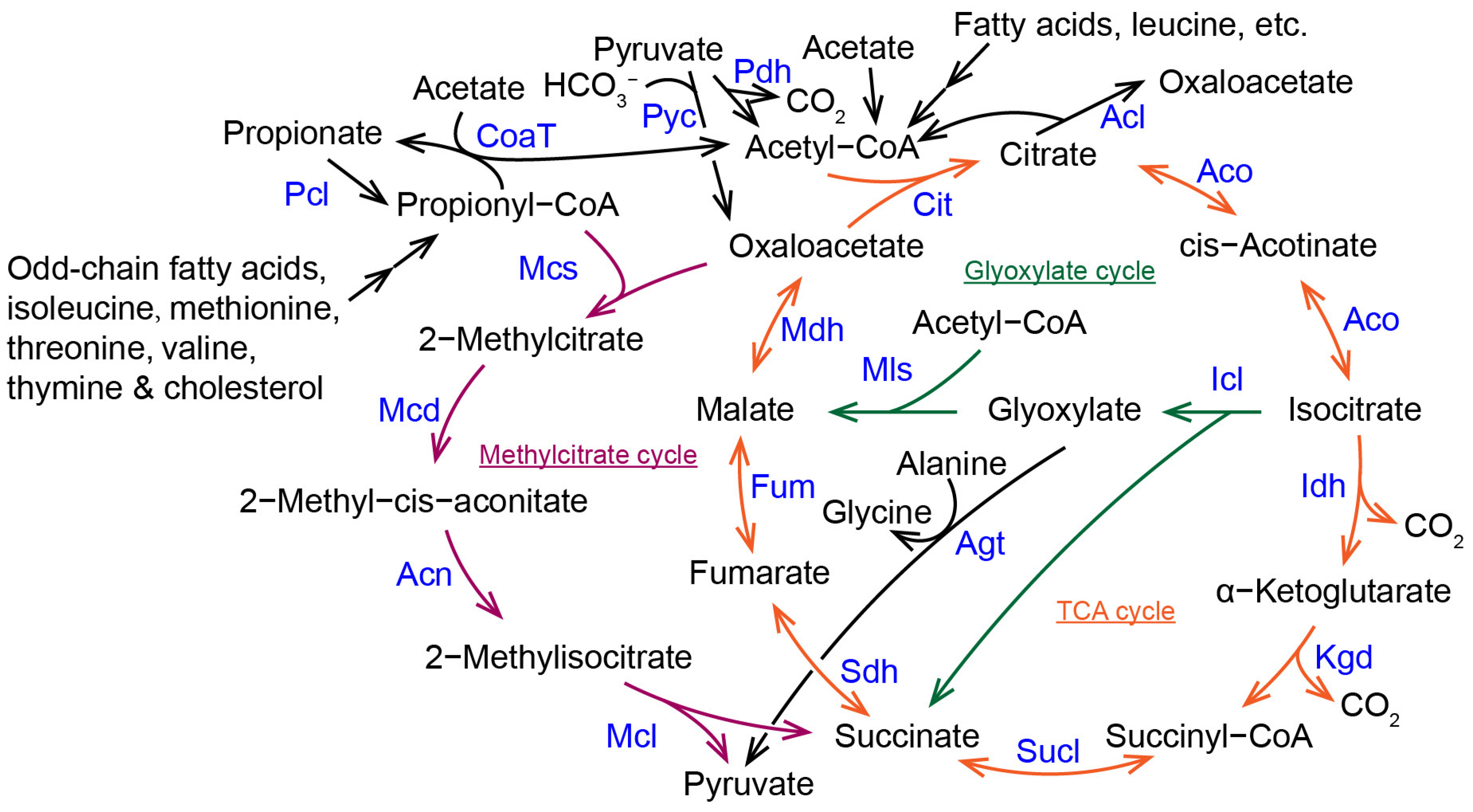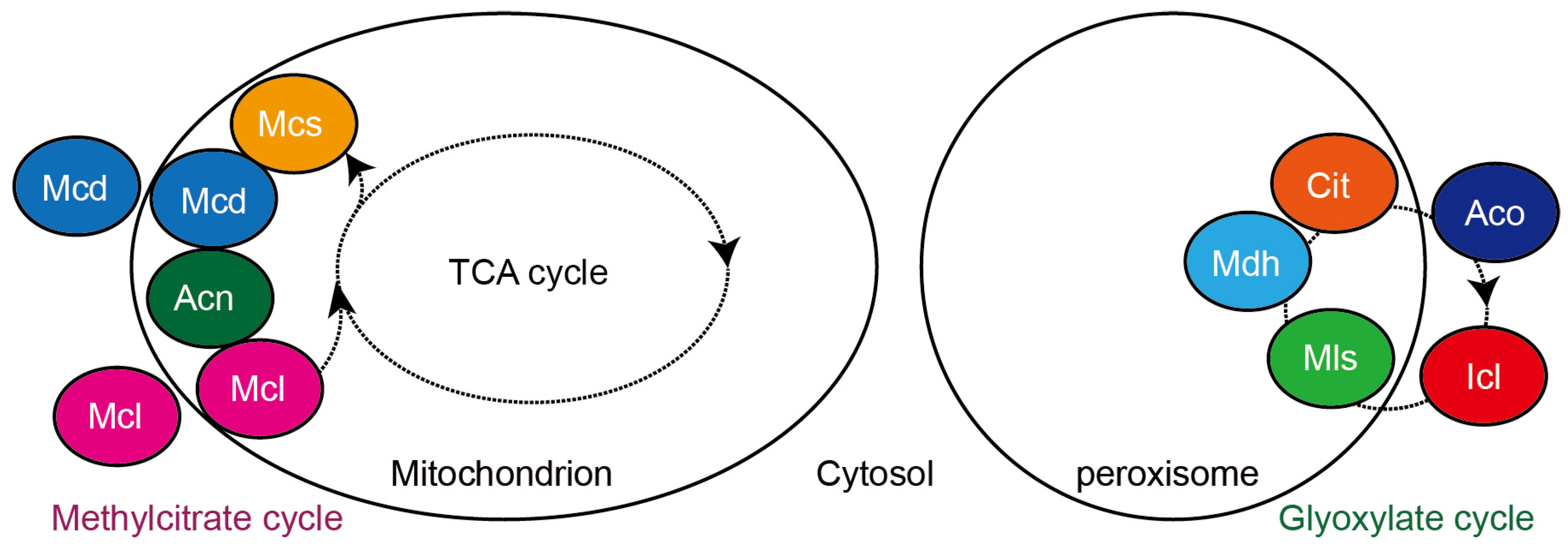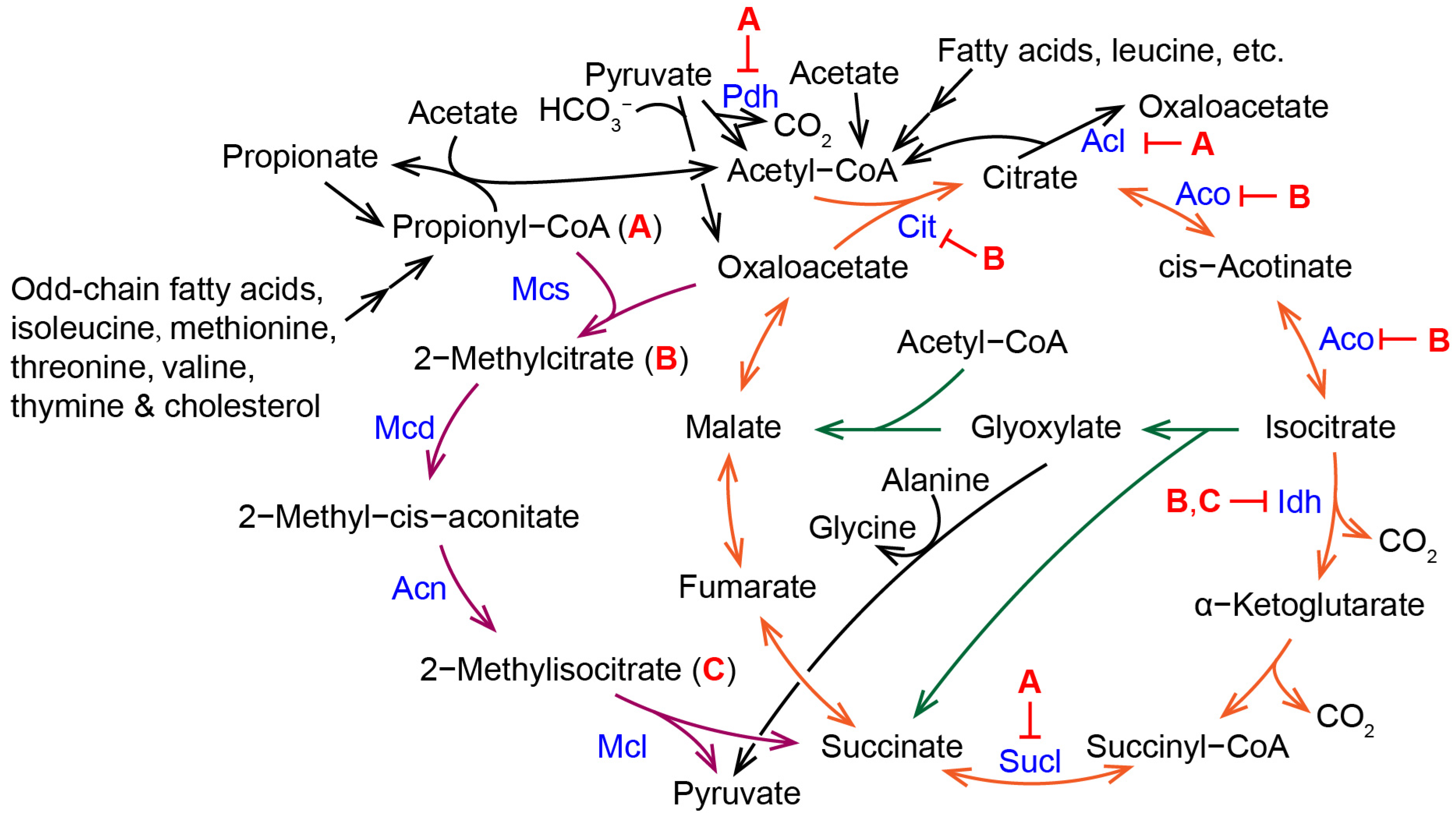The Methylcitrate Cycle and Its Crosstalk with the Glyoxylate Cycle and Tricarboxylic Acid Cycle in Pathogenic Fungi
Abstract
1. Introduction
2. Function of Methylcitrate Cycle in Pathogenic Fungi
2.1. Carbon and Nitrogen Source Utilization and Mycelial Growth
2.2. Pathogenicity
2.3. Asexual and Sexual Reproduction
2.4. Toxins and Melanin Synthesis
2.5. Other Physiological Processes
3. Relationship between Citrate Synthase of the TCA Cycle and 2-Methylcitrate Synthase in the Methylcitrate Cycle
4. Relationship between Isocitrate Lyase of the Glyoxylate Cycle and 2-Methylisocitrate Lyase of the Methylcitrate Cycle
5. Compartmentalization of the TCA Cycle, the Methylcitrate Cycle, and the Glyoxylate Cycle In Vivo
6. Interplay between the TCA Cycle, the Methylcitrate Cycle, and the Glyoxylate Cycle
7. The Methylcitrate Cycle as a Potential Target for Antifungal Compounds
8. Regulation of the Methylcitrate Cycle and the Glyoxylate Cycle
9. Future Perspectives
Author Contributions
Funding
Institutional Review Board Statement
Informed Consent Statement
Data Availability Statement
Conflicts of Interest
Sample Availability
References
- Schwab, M.A.; Sauer, S.W.; Okun, J.G.; Nijtmans, L.G.; Rodenburg, R.J.; van den Heuvel, L.P.; Dröse, S.; Brandt, U.; Hoffmann, G.F.; Ter Laak, H.; et al. Secondary mitochondrial dysfunction in propionic aciduria: A pathogenic role for endogenous mitochondrial toxins. Biochem. J. 2006, 398, 107–112. [Google Scholar] [CrossRef]
- Graham, I.A.; Eastmond, P.J. Pathways of straight and branched chain fatty acid catabolism in higher plants. Prog. Lipid Res. 2002, 41, 156–181. [Google Scholar] [CrossRef]
- Halarnkar, P.P.; Blomquist, G.J. Comparative aspects of propionate metabolism. Comp. Biochem. Physiol. B-Biochem. Mol. Biol. 1989, 92, 227–231. [Google Scholar] [CrossRef]
- Tirosh, A.; Calay, E.S.; Tuncman, G.; Claiborn, K.C.; Inouye, K.E.; Eguchi, K.; Alcala, M.; Rathaus, M.; Hollander, K.S.; Ron, I.; et al. The short-chain fatty acid propionate increases glucagon and FABP4 production, impairing insulin action in mice and humans. Sci. Transl. Med. 2019, 11, eaav0120. [Google Scholar] [CrossRef]
- Moura, A.; Savageau, M.A.; Alves, R. Relative amino acid composition signatures of organisms and environments. PLoS ONE 2013, 8, e77319. [Google Scholar] [CrossRef]
- Peyraud, R.; Kiefer, P.; Christen, P.; Massou, S.; Portais, J.C.; Vorholt, J.A. Demonstration of the ethylmalonyl-CoA pathway by using 13C metabolomics. Proc. Natl. Acad. Sci. USA 2009, 106, 4846–4851. [Google Scholar] [CrossRef]
- Pronk, J.T.; van der Linden-Beuman, A.; Verduyn, C.; Scheffers, W.A.; van Dijken, J.P. Propionate metabolism in Saccharomyces cerevisiae: Implications for the metabolon hypothesis. Microbiology 1994, 140, 717–722. [Google Scholar] [CrossRef]
- Uchiyama, H.; Ando, M.; Toyonaka, Y.; Tabuchi, T. Subcellular localization of the methylcitric-acid-cycle enzymes in propionate metabolism of Yarrowia lipolytica. Eur. J. Biochem. 1982, 125, 523–527. [Google Scholar] [CrossRef]
- Otzen, C.; Bardl, B.; Jacobsen, I.D.; Nett, M.; Brock, M. Candida albicans utilizes a modified β-oxidation pathway for the degradation of toxic propionyl-CoA. J. Biol. Chem. 2014, 289, 8151–8169. [Google Scholar] [CrossRef]
- Brock, M.; Fischer, R.; Linder, D.; Buckel, W. Methylcitrate synthase from Aspergillus nidulans: Implications for propionate as an antifungal agent. Mol. Microbiol. 2000, 35, 961–973. [Google Scholar] [CrossRef]
- Brock, M.; Maerker, C.; Schütz, A.; Völker, U.; Buckel, W. Oxidation of propionate to pyruvate in Escherichia coli. Involvement of methylcitrate dehydratase and aconitase. Eur. J. Biochem. 2002, 269, 6184–6194. [Google Scholar] [CrossRef]
- Cheema-Dhadli, S.; Leznoff, C.C.; Halperin, M.L. Effect of 2-methylcitrate on citrate metabolism: Implications for the management of patients with propionic acidemia and methylmalonic aciduria. Pediatr. Res. 1975, 9, 905–908. [Google Scholar] [CrossRef] [PubMed]
- Yan, Y.; Wang, H.; Zhu, S.; Wang, J.; Liu, X.; Lin, F.; Lu, J. The methylcitrate cycle is required for development and virulence in the rice blast fungus Pyricularia oryzae. Mol. Plant. Microbe. Interact. 2019, 32, 1148–1161. [Google Scholar] [CrossRef] [PubMed]
- Maerker, C.; Rohde, M.; Brakhage, A.A.; Brock, M. Methylcitrate synthase from Aspergillus fumigatus. Propionyl-CoA affects polyketide synthesis, growth, and morphology of conidia. FEBS J. 2005, 272, 3615–3630. [Google Scholar] [CrossRef]
- Feng, J.; He, L.; Xiao, X.; Chen, Z.; Chen, C.; Chu, J.; Lu, S.; Li, X.; Mylonakis, E.; Xi, L. Methylcitrate cycle gene MCD is essential for the virulence of Talaromyces marneffei. Med. Mycol. 2020, 58, 351–361. [Google Scholar] [CrossRef]
- Lee, S.H.; Han, Y.K.; Yun, S.H.; Lee, Y.W. Roles of the glyoxylate and methylcitrate cycles in sexual development and virulence in the cereal pathogen Gibberella zeae. Eukaryot. Cell 2009, 8, 1155–1164. [Google Scholar] [CrossRef] [PubMed]
- Brock, M. Generation and phenotypic characterization of Aspergillus nidulans methylisocitrate lyase deletion mutants: Methylisocitrate inhibits growth and conidiation. Appl. Environ. Microbiol. 2005, 71, 5465–5475. [Google Scholar] [CrossRef]
- Dubey, M.K.; Broberg, A.; Jensen, D.F.; Karlsson, M. Role of the methylcitrate cycle in growth, antagonism, and induction of systemic defence responses in the fungal biocontrol agent Trichoderma atroviride. Microbiology 2013, 159, 2492–2500. [Google Scholar] [CrossRef]
- Ibrahim-Granet, O.; Dubourdeau, M.; Latgé, J.P.; Ave, P.; Huerre, M.; Brakhage, A.A.; Brock, M. Methylcitrate synthase from Aspergillus fumigatus is essential for manifestation of invasive aspergillosis. Cell. Microbiol. 2008, 10, 134–148. [Google Scholar] [CrossRef]
- Lima, R.M.; Silva, K.S.F.E.; Silva, L.D.C.; Ribeiro, J.F.R.; Neves, B.J.; Brock, M.; Soares, C.M.A.; da Silva, R.A.; Pereira, M. A structure-based approach for the discovery of inhibitors against methylcitrate synthase of Paracoccidioides lutzii. J. Biomol. Struct. Dyn. 2022, 40, 9361–9373. [Google Scholar] [CrossRef]
- Zhang, Y.Q.; Keller, N.P. Blockage of methylcitrate cycle inhibits polyketide production in Aspergillus nidulans. Mol. Microbiol. 2004, 52, 541–550. [Google Scholar] [CrossRef]
- Zhang, Y.Q.; Brock, M.; Keller, N.P. Connection of propionyl-CoA metabolism to polyketide biosynthesis in Aspergillus nidulans. Genetics 2004, 168, 785–794. [Google Scholar] [CrossRef] [PubMed]
- Brock, M.; Buckel, W. On the mechanism of action of the antifungal agent propionate-Propionyl-CoA inhibits glucose metabolism in Aspergillus nidulans. Eur. J. Biochem. 2004, 271, 3227–3241. [Google Scholar] [CrossRef] [PubMed]
- Micalizzi, E.W.; Golshani, A.; Smith, M.L. Propionic acid disrupts endocytosis, cell cycle, and cellular respiration in yeast. BMC Res. Notes 2021, 14, 335. [Google Scholar] [CrossRef]
- Schlachter, C.R.; Klapper, V.; Radford, T.; Chruszcz, M. Comparative studies of Aspergillus fumigatus 2-methylcitrate synthase and human citrate synthase. Biol. Chem. 2019, 400, 1567–1581. [Google Scholar] [CrossRef] [PubMed]
- Graybill, E.R.; Rouhier, M.F.; Kirby, C.E.; Hawes, J.W. Functional comparison of citrate synthase isoforms from S. cerevisiae. Arch. Biochem. Biophys. 2007, 465, 26–37. [Google Scholar] [CrossRef]
- Lewin, A.S.; Hines, V.; Small, G.M. Citrate synthase encoded by the CIT2 gene of Saccharomyces cerevisiae is peroxisomal. Mol. Cell. Biol. 1990, 10, 1399–1405. [Google Scholar] [CrossRef]
- Hapeta, P.; Rakicka-Pustułka, M.; Juszczyk, P.; Robak, M.; Rymowicz, W.; Lazar, Z. Overexpression of citrate synthase increases isocitric acid biosynthesis in the yeast Yarrowia lipolytica. Sustainability 2020, 12, 7364. [Google Scholar] [CrossRef]
- Gerike, U.; Hough, D.W.; Russell, N.J.; Dyall-Smith, M.L.; Danson, M.J. Citrate synthase and 2-methylcitrate synthase: Structural, functional and evolutionary relationships. Microbiology 1998, 144, 929–935. [Google Scholar] [CrossRef] [PubMed]
- Lorenz, M.C.; Fink, G.R. The glyoxylate cycle is required for fungal virulence. Nature 2001, 412, 83–86. [Google Scholar] [CrossRef] [PubMed]
- Wang, Z.Y.; Thornton, C.R.; Kershaw, M.J.; Debao, L.; Talbot, N.J. The glyoxylate cycle is required for temporal regulation of virulence by the plant pathogenic fungus Magnaporthe grisea. Mol. Microbiol. 2003, 47, 1601–1612. [Google Scholar] [CrossRef] [PubMed]
- Müller, S.; Fleck, C.B.; Wilson, D.; Hummert, C.; Hube, B.; Brock, M. Gene acquisition, duplication and metabolic specification: The evolution of fungal methylisocitrate lyases. Environ. Microbiol. 2011, 13, 1534–1548. [Google Scholar] [CrossRef] [PubMed]
- Brock, M.; Darley, D.; Textor, S.; Buckel, W. 2-Methylisocitrate lyases from the bacterium Escherichia coli and the filamentous fungus Aspergillus nidulans—Characterization and comparison of both enzymes. Eur. J. Biochem. 2001, 268, 3577–3586. [Google Scholar] [CrossRef]
- Cao, H.; Huang, P.; Yan, Y.; Shi, Y.; Dong, B.; Liu, X.; Ye, L.; Lin, F.; Lu, J. The basic helix-loop-helix transcription factor Crf1 is required for development and pathogenicity of the rice blast fungus by regulating carbohydrate and lipid metabolism. Environ. Microbiol. 2018, 20, 3427–3441. [Google Scholar] [CrossRef] [PubMed]
- Kuroki, M.; Shiga, Y.; Narukawa-Nara, M.; Arazoe, T.; Kamakura, T. Extremely low concentrations of acetic acid stimulate cell differentiation in rice blast fungus. Iscience 2020, 23, 100786. [Google Scholar] [CrossRef]
- Li, W.; Long, Q.; Wu, H.; Zhou, Y.; Duan, L.; Yuan, H.; Ding, Y.; Huang, Y.; Wu, Y.; Huang, J.; et al. Nuclear localization of mitochondrial TCA cycle enzymes modulates pluripotency via histone acetylation. Nat. Commun. 2022, 13, 7414. [Google Scholar] [CrossRef] [PubMed]
- Nagaraj, R.; Sharpley, M.S.; Chi, F.; Braas, D.; Zhou, Y.; Kim, R.; Clark, A.T.; Banerjee, U. Nuclear localization of mitochondrial TCA cycle enzymes as a critical step in mammalian zygotic genome activation. Cell 2017, 168, 210–223. [Google Scholar] [CrossRef] [PubMed]
- Liu, X.; Si, W.; He, L.; Yang, J.; Peng, Y.; Ren, J.; Liu, X.; Jin, T.; Yu, H.; Zhang, Z.; et al. The existence of a nonclassical TCA cycle in the nucleus that wires the metabolic-epigenetic circuitry. Signal Transduct. Target. Ther. 2021, 6, 375. [Google Scholar] [CrossRef]
- Huang, F.; Luo, X.; Ou, Y.; Gao, Z.; Tang, Q.; Chu, Z.; Zhu, X.; He, Y. Control of histone demethylation by nuclear-localized α-ketoglutarate dehydrogenase. Science 2023, 381, eadf8822. [Google Scholar] [CrossRef]
- Limenitakis, J.; Oppenheim, R.D.; Creek, D.J.; Foth, B.J.; Barrett, M.P.; Soldati-Favre, D. The 2-methylcitrate cycle is implicated in the detoxification of propionate in Toxoplasma gondii. Mol. Microbiol. 2013, 87, 894–908. [Google Scholar] [CrossRef]
- Kunze, M.; Pracharoenwattana, I.; Smith, S.M.; Hartig, A. A central role for the peroxisomal membrane in glyoxylate cycle function. Biochim. Biophys. Acta-Mol. Cell Res. 2006, 1763, 1441–1452. [Google Scholar] [CrossRef]
- Luttik, M.A.; Kötter, P.; Salomons, F.A.; van der Klei, I.J.; van Dijken, J.P.; Pronk, J.T. The Saccharomyces cerevisiae ICL2 gene encodes a mitochondrial 2-methylisocitrate lyase involved in propionyl-coenzyme A metabolism. J. Bacteriol. 2000, 182, 7007–7013. [Google Scholar] [CrossRef] [PubMed]
- Jia, Y.K.; Bécam, A.M.; Herbert, C.J. The CIT3 gene of Saccharomyces cerevisiae encodes a second mitochondrial isoform of citrate synthase. Mol. Microbiol. 1997, 24, 53–59. [Google Scholar] [CrossRef] [PubMed]
- Piekarska, K.; Hardy, G.; Mol, E.; van den Burg, J.; Strijbis, K.; van Roermund, C.; van den Berg, M.; Distel, B. The activity of the glyoxylate cycle in peroxisomes of Candida albicans depends on a functional beta-oxidation pathway: Evidence for reduced metabolite transport across the peroxisomal membrane. Microbiology 2008, 154, 3061–3072. [Google Scholar] [CrossRef]
- Abba’, S.; Balestrini, R.; Benedetto, A.; Rottensteiner, H.; De Lucas, J.R.; Bonfante, P. The role of the glyoxylate cycle in the symbiotic fungus Tuber borchii: Expression analysis and subcellular localization. Curr. Genet. 2007, 52, 159–170. [Google Scholar] [CrossRef] [PubMed]
- Gibson, N.; McAlister-Henn, L. Physical and genetic interactions of cytosolic malate dehydrogenase with other gluconeogenic enzymes. J. Biol. Chem. 2003, 278, 25628–25636. [Google Scholar] [CrossRef]
- Minard, K.I.; McAlister-Henn, L. Isolation, nucleotide sequence analysis, and disruption of the MDH2 gene from Saccharomyces cerevisiae: Evidence for three isozymes of yeast malate dehydrogenase. Mol. Cell. Biol. 1991, 11, 370–380. [Google Scholar] [CrossRef]
- Gabay-Maskit, S.; Cruz-Zaragoza, L.D.; Shai, N.; Eisenstein, M.; Bibi, C.; Cohen, N.; Hansen, T.; Yifrach, E.; Harpaz, N.; Belostotsky, R.; et al. A piggybacking mechanism enables peroxisomal localization of the glyoxylate cycle enzyme Mdh2 in yeast. J. Cell Sci. 2020, 133, jcs244376. [Google Scholar] [CrossRef]
- Fleck, C.B.; Brock, M. Characterization of an acyl-CoA: Carboxylate CoA-transferase from Aspergillus nidulans involved in propionyl-CoA detoxification. Mol. Microbiol. 2008, 68, 642–656. [Google Scholar] [CrossRef]
- Santos, L.P.A.; Assunção, L.D.P.; Lima, P.S.; Tristão, G.B.; Brock, M.; Borges, C.L.; Silva-Bailão, M.G.; Soares, C.M.A.; Bailão, A.M. Propionate metabolism in a human pathogenic fungus: Proteomic and biochemical analyses. IMA Fungus 2020, 11, 9. [Google Scholar] [CrossRef]
- Rocha, O.B.; Freitas, E.; Silva, K.S.; Santos, T.G.; Moraes, D.; Assunção, L.D.P.; Bailão, A.M.; Soares, C.M.A.; Pereira, M. New methylcitrate synthase inhibitor induces proteolysis, lipid degradation and pyruvate excretion in Paracoccidioides brasiliensis. J. Fungi 2023, 9, 108. [Google Scholar] [CrossRef] [PubMed]
- Papanikolaou, S.; Beopoulos, A.; Koletti, A.; Thevenieau, F.; Koutinas, A.A.; Nicaud, J.M.; Aggelis, G. Importance of the methyl-citrate cycle on glycerol metabolism in the yeast Yarrowia lipolytica. J. Biotechnol. 2013, 168, 303–314. [Google Scholar] [CrossRef] [PubMed]
- Heinisch, J.J.; Valdés, E.; Alvarez, J.; Rodicio, R. Molecular genetics of ICL2, encoding a non-functional isocitrate lyase in Saccharomyces cerevisiae. Yeast 1996, 12, 1285–1295. [Google Scholar] [CrossRef]
- Huang, Z.; Cao, H.; Wang, H.; Huang, P.; Wang, J.; Cai, Y.Y.; Wang, Q.; Li, Y.; Wang, J.; Liu, X.; et al. The triglyceride catabolism regulated by a serine/threonine protein phosphatase, Smek1, is required for development and plant infection in Magnaporthe oryzae. Mol. Plant Pathol. 2023, 24, 1256–1272. [Google Scholar] [CrossRef] [PubMed]





Disclaimer/Publisher’s Note: The statements, opinions and data contained in all publications are solely those of the individual author(s) and contributor(s) and not of MDPI and/or the editor(s). MDPI and/or the editor(s) disclaim responsibility for any injury to people or property resulting from any ideas, methods, instructions or products referred to in the content. |
© 2023 by the authors. Licensee MDPI, Basel, Switzerland. This article is an open access article distributed under the terms and conditions of the Creative Commons Attribution (CC BY) license (https://creativecommons.org/licenses/by/4.0/).
Share and Cite
Huang, Z.; Wang, Q.; Khan, I.A.; Li, Y.; Wang, J.; Wang, J.; Liu, X.; Lin, F.; Lu, J. The Methylcitrate Cycle and Its Crosstalk with the Glyoxylate Cycle and Tricarboxylic Acid Cycle in Pathogenic Fungi. Molecules 2023, 28, 6667. https://doi.org/10.3390/molecules28186667
Huang Z, Wang Q, Khan IA, Li Y, Wang J, Wang J, Liu X, Lin F, Lu J. The Methylcitrate Cycle and Its Crosstalk with the Glyoxylate Cycle and Tricarboxylic Acid Cycle in Pathogenic Fungi. Molecules. 2023; 28(18):6667. https://doi.org/10.3390/molecules28186667
Chicago/Turabian StyleHuang, Zhicheng, Qing Wang, Irshad Ali Khan, Yan Li, Jing Wang, Jiaoyu Wang, Xiaohong Liu, Fucheng Lin, and Jianping Lu. 2023. "The Methylcitrate Cycle and Its Crosstalk with the Glyoxylate Cycle and Tricarboxylic Acid Cycle in Pathogenic Fungi" Molecules 28, no. 18: 6667. https://doi.org/10.3390/molecules28186667
APA StyleHuang, Z., Wang, Q., Khan, I. A., Li, Y., Wang, J., Wang, J., Liu, X., Lin, F., & Lu, J. (2023). The Methylcitrate Cycle and Its Crosstalk with the Glyoxylate Cycle and Tricarboxylic Acid Cycle in Pathogenic Fungi. Molecules, 28(18), 6667. https://doi.org/10.3390/molecules28186667





